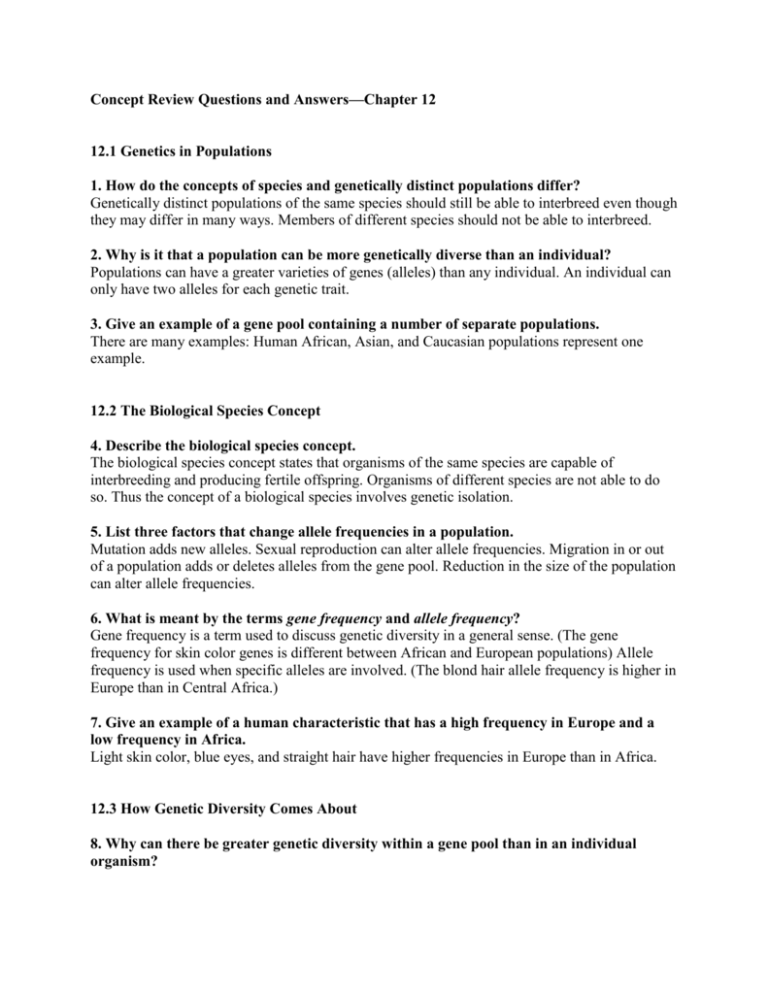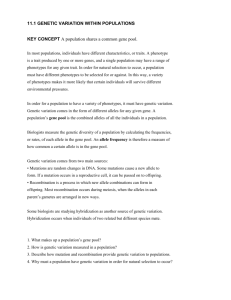Chapter 12
advertisement

Concept Review Questions and Answers—Chapter 12 12.1 Genetics in Populations 1. How do the concepts of species and genetically distinct populations differ? Genetically distinct populations of the same species should still be able to interbreed even though they may differ in many ways. Members of different species should not be able to interbreed. 2. Why is it that a population can be more genetically diverse than an individual? Populations can have a greater varieties of genes (alleles) than any individual. An individual can only have two alleles for each genetic trait. 3. Give an example of a gene pool containing a number of separate populations. There are many examples: Human African, Asian, and Caucasian populations represent one example. 12.2 The Biological Species Concept 4. Describe the biological species concept. The biological species concept states that organisms of the same species are capable of interbreeding and producing fertile offspring. Organisms of different species are not able to do so. Thus the concept of a biological species involves genetic isolation. 5. List three factors that change allele frequencies in a population. Mutation adds new alleles. Sexual reproduction can alter allele frequencies. Migration in or out of a population adds or deletes alleles from the gene pool. Reduction in the size of the population can alter allele frequencies. 6. What is meant by the terms gene frequency and allele frequency? Gene frequency is a term used to discuss genetic diversity in a general sense. (The gene frequency for skin color genes is different between African and European populations) Allele frequency is used when specific alleles are involved. (The blond hair allele frequency is higher in Europe than in Central Africa.) 7. Give an example of a human characteristic that has a high frequency in Europe and a low frequency in Africa. Light skin color, blue eyes, and straight hair have higher frequencies in Europe than in Africa. 12.3 How Genetic Diversity Comes About 8. Why can there be greater genetic diversity within a gene pool than in an individual organism? An individual can only contain a maximum of two different alleles for each characteristic, one from each parent. However, within a gene pool of several individuals there may be alleles in one individual that are not present in others so there is greater genetic diversity. 12.4 Why Genetically Distinct Populations Exist 9. List three mechanisms that contribute to genetic diversity. Mutations; sexual reproduction and migration 10. What happens to the degree of genetic diversity as a population decreases in size? Genetic diversity decreases. 11. List four processes that can lead to local, genetically distinct populations. Adaptation to local environmental conditions, founding of a population by a small number of individuals that have particular kinds of genes present, a severe reduction in the size of a local population may result in a population which differs from others of the same species, and barriers to movement that prevent exchange of genes with other populations. 12. In what way are the founder effect and a genetic bottleneck similar in their affect on the genetic diversity of a local population? Both situations result in the development of a population from a small number of individuals and, therefore, are likely to have reduced genetic diversity. 12.5 Genetic Diversity in Domesticated Plants and Animals 13. How do the genetic combinations in clones and sexually reproducing populations differ? All the individuals in a clone are genetically identical. All the individuals produced by sexual reproduction are genetically unique. 14. How is a clone developed? What are its benefits and drawbacks? Clones are developed by asexual reproduction from one individual, so they are genetically identical. If it is desirable to have identical individuals—identical fruits or colors or height, etc.—clones are an advantage. The major drawbacks are that sexual reproduction must be prevented to maintain a clone and there is no genetic diversity within the clone population. 15. How is an intraspecific hybrid formed? What are its benefits and drawbacks? An intraspecific hybrid is produced by mating different populations of the same species. Generally the mating is between highly inbred strains with particular desirable characteristics. The major benefit is that the outcome of the cross is highly predictable and has certain highly valued characteristics. The major drawback is that the offspring will not be similar to the parents and, therefore, each generation must be produced by the making of the same cross. 16. Why is genetic diversity in domesticated plants and animals reduced? Genetic diversity is reduced both on purpose and inadvertently. When domesticated organisms are bred to produce specific desirable characteristics there is a high likelihood that some other genes will be lost from the population. Prevention of outbreeding with wild relatives also reduces genetic diversity. 12.6 Is It a Species or Not? The Evidence 17. List four techniques used to distinguish one species from another. There are many techniques: morphological differences, behavioral differences, genetic differences, and metabolic differences are commonly used as tools to distinguish species. 18. Explain why the terms reproductively isolated and species are related. Organisms that are of different species are not able to interbreed, therefore, they are reproductively isolated from one another. 12.7 Human Population Genetics 19. Give an example of a human population with a high frequency of a deleterious allele. Ashkenazi Jews and Tay-Sachs disease. Central African populations and sickle-cell anemia. 12.8 Ethics and Human Population Genetics 20. What is the role of a genetic counselor? One of the things a genetics counselor is trained to do is consult with people to determine the likelihood of passing on that characteristic to the next generation before deciding whether or not to have children. 21. What is amniocentesis? A medical procedure that samples amniotic fluid 22. What were eugenics laws? List two facts about human genetics that the advocates of eugenics failed to consider. Eugenics laws were designed to remove bad genes from the human population. Early proponents of such laws failed to understand that it is impossible to remove recessive genes from populations. They also failed to understand that many characteristics are significantly altered by environment.









